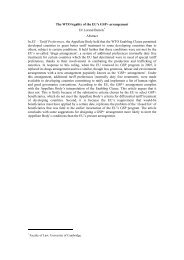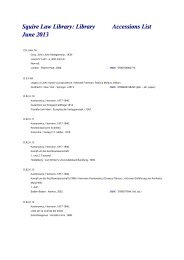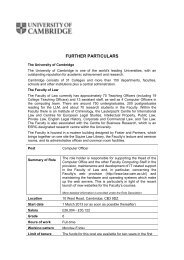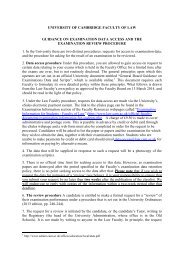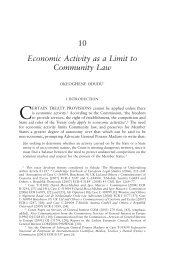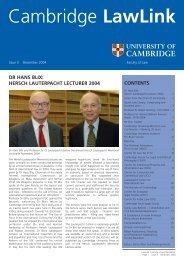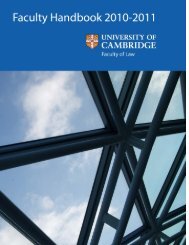start the download - Faculty of Law - University of Cambridge
start the download - Faculty of Law - University of Cambridge
start the download - Faculty of Law - University of Cambridge
You also want an ePaper? Increase the reach of your titles
YUMPU automatically turns print PDFs into web optimized ePapers that Google loves.
LL.M. HANDBOOK 2011-2012You should be familiar with <strong>the</strong> way in which law reports are cited. Such citations are amatter <strong>of</strong> firm convention, which you should follow exactly. You can always check <strong>the</strong> form<strong>of</strong> a reference to a particular series <strong>of</strong> reports by consulting <strong>the</strong> Legal Journals Index, heldin <strong>the</strong> Squire Library.Two additional conventions should be noted. First, if a case is reported in more than oneset <strong>of</strong> reports, <strong>the</strong>re are two alternative ways to cite it. You could list all <strong>the</strong> references, butthis can be an unnecessarily lengthy process. Instead, it is more usual to just give onereference, to <strong>the</strong> most “<strong>of</strong>ficial” set <strong>of</strong> reports in which <strong>the</strong> case appears. This is a matter <strong>of</strong>strict hierarchy, <strong>start</strong>ing with <strong>the</strong> <strong>Law</strong> Reports <strong>the</strong>mselves (A.C., Q.B., etc.), <strong>the</strong>n movingdown to <strong>the</strong> Weekly <strong>Law</strong> Reports, <strong>the</strong>n to specialised reports which give <strong>the</strong> judgments infull (e.g. Family <strong>Law</strong> Reports, Industrial Relations <strong>Law</strong> Reports, Housing <strong>Law</strong> Reports) andto <strong>the</strong> All England Reports, <strong>the</strong>n to periodicals which give abbreviated case reports (e.g.N.L.J., Legal Action) and finally to reports in <strong>the</strong> newspapers (Times, Independent, etc.).The o<strong>the</strong>r convention worth noting is <strong>the</strong> use <strong>of</strong> round and square brackets. Strictly, squarebrackets around <strong>the</strong> date in a citation should be used if <strong>the</strong> date is an essential part <strong>of</strong> <strong>the</strong>reference, and round brackets should be used if it is not. For example, with cases reportedin <strong>the</strong> <strong>Law</strong> Reports, <strong>the</strong> date is necessary for finding <strong>the</strong> case, since <strong>the</strong> volumes are notnumbered sequentially but by year (if at all). Therefore square brackets are used:Bloggs v Inland Revenue Commissioners [1997] 1 Q.B. 354.In some o<strong>the</strong>r reports, <strong>the</strong> volumes are traced by volume numbers which are sequentialfrom year to year. Here <strong>the</strong> date is not a necessary part <strong>of</strong> <strong>the</strong> citation at all, but <strong>the</strong> year inwhich <strong>the</strong> case was decided (not necessarily when it was reported) is given, this time inround brackets, for example:Bloggs v Bloggs (1996) STC 87.Different publications adopt different “house styles” with regard to matters such as whe<strong>the</strong>rfull-stops are included in reference abbreviations (i.e. whe<strong>the</strong>r to write A.C., All E.R.,W.L.R., etc., or AC, All ER, WLR . . .). You may choose which style to adopt; you may, forexample, follow <strong>the</strong> conventions used in <strong>the</strong> <strong>Cambridge</strong> <strong>Law</strong> Journal (see <strong>the</strong> Notes forContributors given each year in <strong>the</strong> November issue). Whatever you do, <strong>the</strong> guidingprinciple, as always, is to be consistent.AbbreviationsIt is perfectly acceptable to use <strong>the</strong> well-known legal abbreviations which are in commonuse without any explanation (e.g. Q.B., All E.R., M.L.R., C.L.J., etc.). However, if you wishto use abbreviations which are less universally found in British legal publications, such asabbreviations <strong>of</strong> <strong>the</strong> titles <strong>of</strong> journals, or <strong>of</strong> <strong>the</strong> names <strong>of</strong> organisations, you should indicatewhat <strong>the</strong> abbreviation stands for. This can be done by using its full name <strong>the</strong> first time yourefer to it, followed by <strong>the</strong> abbreviation in brackets. Ano<strong>the</strong>r option is to place a Table <strong>of</strong>Abbreviations at <strong>the</strong> front <strong>of</strong> your <strong>the</strong>sis/essay. If you do so, this should be placed after <strong>the</strong>title page but before <strong>the</strong> Contents page.30



